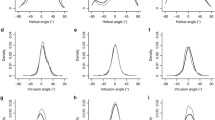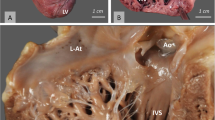Summary
311 hearts of fetuses, of premature and neonate babies, of preschool and school children were examined, irrespective of basic disease and cause of death. 63 hearts did not show any pathological alterations. They served as a control group. The fibers of 27 hearts of fetuses, premature and mature neonate babies were homogeneous: The close packing as well as the reduced number of myofibrils in some regions of the heart did not correspond to hearts of the same age and size of the control group.
The following changes were found individually or in combination within the remaining 200 hearts:
Perinuclear vacuoles and acidophilic fibers, acidophilic necroses, scars with or without calcification, interstitial haemorrhages, parietal thrombi, endocarditis and myocarditis.
Prominent characteristics are perinuclear vacuoles, acidophilic fibers and acidophilic necroses. This combination often shows a characteristic morphological pattern: inner layer with acidophilic necroses, middle layer with acidophilia, and outer layer consisting of fibers with perinuclear vacuoles. This combination and the trilaminar arrangement lead to the conclusion that they may be caused by hypoxaemia, ischemia or hypoxidosis. Vacuoles and acidophilia are most likely to be reversible.
According to their frequency, they appear to correlate with certain diseases (table 3), but none of the changes are specific for a certain disease:
Perinuclear vacuoles, acidophilic fibers and acidophilic necroses very often exist with pulmonary diseases, with general infections and erythroblastosis. Interstitial haemorrhages and parietal thrombi can be traced in increasing numbers in traumas showing disseminated intravascular coagulation.
Hypertrophic fibers are frequent in congenital heart disease, mostly in combination with acidophilic fibers and especially with scars.
Further studies should aim at establishing a correlation between morphological and clinical observations. This paper suggests further studies in the field of morphology examining equivalent surgical material with the electron microscope.
Zusammenfassung
311 Herzen von Feten, Frühgeborenen, Säuglingen und Kindern wurden unabhängig von Grundleiden und Todesursache untersucht. 63 Herzen hatten keinen pathologischen Befund und dienten als Kontrollgruppe. 27 Herzen von Kindern unter 49 cm zeigten keine einheitliche Faserstruktur; Kerndichte und Myofibrillenbestand entsprachen nicht gleich alten und gleich großen Kindern. 21 Kinder hatten Herzen mit unterschiedlicher Muskelhypertrophie.
An den verbliebenen 200 Herzen kamen folgende Veränderungen allein oder in Kombination vor:
Perinukleäre Vakuolen und azidophile Fasern, azidophile Nekrosen, Narben mit und ohne Verkalkung; interstitielle Blutungen, parietale Thromben, Endokarditis und Myokarditis.
Hervorstechendes Merkmal sind perinukleäre Vakuolen, Faserazidophilie und azidophile Nekrosen. Sie sind oft miteinander kombiniert und können schichtenförmig geordnet sein: Innenschicht mit azidophilen Nekrosen, Mittelschicht mit Faserazidophilie und Außenschicht mit Fasern mit perinukleären Vakuolen. Diese Kombinationen und ihre schichtenförmige Anordnung zwingen zu dem Schluß, daß sie als Folge von Hypoxämie, Ischämie oder Hypoxidose entstehen. Die Vakuolen und Azidophilie sind wahrscheinlich reversibel. Keine dieser Veränderungen ist krankheitsspezifisch, bei einzelnen Krankheiten jedoch gehäuft (Tab. 3).
Perinukleäre Vakuolen, Faserazidophilie und azidophile Nekrosen kommen bei pulmonalen Erkrankungen, bei Allgemeininfektionen und Erythroblastose vermehrt vor. Interstitielle Blutungen und parietale Thromben sind an den untersuchten Fällen bei Traumen mit Verbrauchskoagulopathie häufig.
Hypertrophierte Fasern gibt es besonders bei konnatalen Herzvitien, meist in einer Kombination von Faserazidophilie und besonders Narben.
Weitere Untersuchungen sollten mit speziellen Methoden morphologische und klinische Befunde korrelieren. Diese Untersuchungen sollen Anregung sein, den elektronenmikroskopischen Äquivalenten dieser Befunde anhand von Operationsmaterial nachzugehen.
Similar content being viewed by others
References
Becker, H., K. Kellerer: Koronarerkrankungen im Säuglings- und Kleinkindesalter. Helvet. paediatr. acta5, 474 (1969).
Becker, V., D. Neubert: Über die Entstehung der hydrophisch-vakuolären Zellentartung. Beitr. path. Anat.120, 319 (1958).
Benirschke, K., S. Kibrik: Acute, aseptic myocarditis and menigoencephalitis in the newborn child with coxsackie virus group B Typ 3. New Engl. J. Med.255, 883 (1956).
Bernreiter, M.: Myocardial infarction in an infant with transposition of the great vessels. J. Amer. med. Ass.167, 459 (1958).
Berry, C. L.: Myocardial ischaemia in infancy and childhood. J. clin. Path.20, 38 (1967).
Bland, E. F., P. D. White, J. Garland: Congenital anomalies of the coronary arteries: Report of an unusual case associated with cardiac hypertrophy. Amer. Heart J.8, 787 (1933).
Bleyl, U., C. M. Büsing, H. Graeff, W. Kuhn: Perinatale Hämostase — Störung nach vorzeitiger Placentalösung. Virchows Arch. path. Anat. Abt. A348, 1 (1969).
Boemke, F., H. J. Schmitt: Untersuchungen über Herzmuskelveränderungen bei kongenitalen Herzfehlern. Virchows Arch. path. Anat.319, 613 (1950).
Bubenzer, J.: Das Myokard in Perinatalperiode und Kindesalter. Inauguraldissertation, Med. Fak. (Aachen 1971).
Büchner, F.: Das morphologische Substrat bei Angina pectoris im Tierexperiment. Beitr. path. Anat.92, 311 (1933).
Büchner, F.: Die pathologische Bedeutung der Hypoxämie. Klin. Wschr.16, 1932 (1937).
Büchner, F.: Die pathogenetische Bedeutung des allgemeinen Sauerstoffmangels. Verh. Dtsch. Ges. Path. (Breslau) 20 (1944).
Büchner, F., S. Onishi: Herzhypertrophie und Herzinsuffizienz in der Sicht der Elektronenmikroskopie. Verlag Urban & Schwarzenberg (München-Berlin-Wien 1970).
Brown, C. E., I. M. Richter: Medical coronary sclerosis in infancy. Arch. Path.31, 449 (1941).
Brown, J. M.: Histological examination of the ventricular myocardium in 2 cases of congenital heart disease. Brit. Heart J26, 778 (1964).
Bühlmeyer, K.: Angeborener Herzfehler als Ursache kardialer Notfallsituationen bei Neugeborenen. Mschr. Kinderheilk.126, 303 (1978).
Burch, G. E., S. C. Sun, K. Chu-Chu, R. S. Shal, H. Colcolough: Interstitial and Coxsackievirus B myocarditis in infants and children. J. Amer. med. Ass.203, 1 (1968).
Davies, P. A.: Bacterial infection in the fetus and newborn. Arch. Dis. Childh.46, 1 (1971).
De La Chapelle, M. D., C. E. Kossmann: Myocarditis. Circulation10, 747 (1954).
Doerr, W.: Pathologie der Organe des Kreislaufs. Handbuch der Allgemeinen Pathologie, Buch III/4. Springer-Verlag (Berlin-Heidelberg-New York 1970).
Easterly, J. R., E. H. Oppenheimer: Some aspects of cardiac pathology in infancy and childhood. I. Neonatal myocardial necroses. Bull. Johns Hopkins Hosp.119, 191–199 (1966).
Easterly, J. R., E. H. Oppenheimer: Some aspects of cardiac pathology in infancy and childhood. II. Unusual coronary endarteritis with congenital cardiac malformations. Bull. Johns Hopkins Hosp.119 343 (1966)
Easterly, J. R., E. H. Oppenheimer: Myocardial and coronary lesions in cardiac malformations. Bull. Johns Hopkins Hosp.120, 317 (1967).
Fangman, R. J., C. A. Hellwig: Histology of coronary arteries in newborn infants. Amer. J. Path.23, 901 (1947).
Franciosi, R. A., W. A. Blanc: Myocardial infarcts in infants and children. A necrops study in congenital heart disease. J. Pediatr.73, 309 (1968).
Gault, M. H., R. Usher: Coronary thrombosis with myocardial infarction in newborn infant. New Engl. J. Med.263, 8, 379 (1960).
Goebel, A., G. Rudolf: Morphologische Veränderungen am Herzen bei der interstitiellen, plasmazellulären Pneumonie. Beitr. path. Anat.115, 561 (1955).
Gross, P.: Concept of Fetal Endocarditis. Arch. Path.31, 163 (1941).
Grundmann, E.: Histologische Untersuchungen über die Wirkung experimentellen Sauerstoffmangels auf das Katzenherz. Zieglers Beitr.111, 36 (1950).
Hastreiter, A. R. R. A. Miller: Management of primary endomyocardial disease. Pediat. clin. N. Amer.11, 401 (1964).
Hause, W. A., G. J. Antell: Arteriosclerosis in infancy. Arch. Path.44, 82 (1947).
Hogg, G. R.: Cardiac lesions in hemolytic disease of the newborn. J. Pediatr.60, 3, 352 (1962).
Hort, W.: Quantitative histologische Untersuchungen an wachsenden Herzen. Virchows Arch. path. Anat.323, 223 (1953).
Kahles, H., M. M. Gebhard, U. A. Me Zoer, H. Nordbeck, C. J. Preusse, P. G. Spieckermann: The role of ATP and lactic acid for mitochondrial function during myocardial ischemia. Basic Res. Cardiol.74, 611 (1979).
Korb, G.: Elektronenmikroskopische Untersuchungen zur Aludrin (Isoproterenolsulfat)-Schädigung des Herzmuskels. Virchows Arch. path. Anat.339, 136 (1965).
Lev, M., J. Craenen, E. C. Lambert: Infantile coronary sclerosis with arterioventricular block. J. Pediatr.70, 87 (1967).
Lind, M. J., G. T. Hultquist: Isolated myocarditis in newborn and young infants. Amer. Heart J.38, 123 (1949).
Lindner, E.: Submikroskopische Untersuchungen über die Herzentwicklung beim Hühnchen. Verh. Anat. Ges. 54. Tagung. Fischer Verlag, Jena, 305 (1957).
Lindner, E.: Die submikroskopische Morphologie des Herzmuskels. Z. Zellforsch.45, 702 (1957).
Linzbach, A. J.: Über die vakuoläre Verfettung der Herzmuskelfasern. Virchows Arch. path. Anat.321, 611 (1952).
Mahnke, P. F., H. Zschoch: Thrombose und Embolie im Kindesalter. Dtsch. med. Wschr.94, 323 (1969).
Martelle, R. R.: Coronary thrombosis in a five mnnths old child. J. Pediatr.46, 322 (1955).
Mölbert, E.: Die Orthologie und Pathologie der Zelle im elektronenmikroskopischen Bild; in: Handbuch der allgemeinen Pathologie II/5 (1968). Stoffwechsel und Feinstruktur der Zelle I.
Müller, E., W. Rotter: Über die histologischen Veränderungen beim akuten Höhentode. Zieglers Beitr.107, 156 (1942).
Neufeld, H. N.: Studies of the coronary arteries in children and their relevance to coronary heart Disease. Eur. J. Cardiol.1/4, 479 (1974).
Nienhaus, H., R. Poche, E. Reimold: Elektrolytverschiebungen, histologische Veränderungen der Organe und Ultrastruktur des Herzmuskels nach Cortisol, Aldosteron und primärem Natriumphosphat bei der Ratte. Virchows Arch. path. Anat.337, 245 (1963).
Onishi, S.: Die Feinstruktur des Herzmuskels nach Aderlaß bei der Ratte. Beitr. path. Anat.136, 96 (1967).
Poche, R.: Submikroskopische Beiträge zur Pathologie der Herzmuskelzelle bei Phosphorvergiftung, Hypertrophie, Atrophie und Kaliummangel. Virchows Arch. path. Anat.331, 165 (1958).
Poche, R.: Die kleinherdige, hyperoxydotische Herzmuskelnekrose. Dtsch. med. Wschr.94, 37, 12, 1855 (1969).
Poche, R.: Über die kleinherdige hypoxydotische Herzmuskelnekrose und ihre Pathogenese. Forum cardiologicum13, 27 (1970).
Roberts, N. K., P. C. Gilette: Electrophysiologic Study of the Conduction System in Normal Children. Pediatrics60, 858 (1977).
Scott, E. P., A. J. Miller: Coronary thrombosis. Report of a case in an infant of 11 months of age. J. Pediatr.28, 478 (1947).
Schaper, J., F. Schwarz, M. Krist, H. Kittstein: Quantitative Morphologie am menschlichen Herzmuskel. 46. Jahrestagung Deutsche Gesellschaft für Herz- und Kreislaufforschung (1980).
Schoenmackers, J.: Koronarwandnekrosen und Blutungen bei einem Neugeborenen. Zbl. allg. Path.94, 91 (1955).
Schoenmackers, J.: Fehlbildungen des Herzens und der großen herznahen Gefäße; in: Handbuch med. Radiol. Bd. X/4. Springer-Verlag (Berlin-Heidelberg-New York 1967).
Singer, H.: Prae- und postoperative Betreuung von Kindern mit angeborenen Herzfehlern. Med. Welt50, 820 (1979).
van Crefeld, S.: Coronary calcification and thrombosis in an infant. Ann. paediatr.157, 84 (1941).
Author information
Authors and Affiliations
Rights and permissions
About this article
Cite this article
Bigalke, K.H. The myocardium and its pathological state during the perinatal period and infancy. Basic Res Cardiol 78, 39–52 (1983). https://doi.org/10.1007/BF01923192
Received:
Issue Date:
DOI: https://doi.org/10.1007/BF01923192




